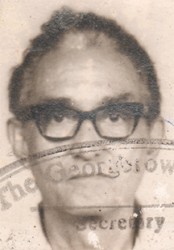The following is an edited version of a tribute given by Major General (rtd) Joseph G Singh at St Andrew’s Kirk, Georgetown, on June 26.
Born on June 25, 1914, Cecil Carl Cunha, MS transitioned last Friday, five days before his 100th birthday. Exactly 10 years ago (June 2004), I published a book titled The Mataruki Trail, which is a record of the work of the Boundary Commission that established the Tri-Junction Point at the head of the east Kutari River, which the joint survey team of the British and Dutch in 1937, verified through detailed on-the-ground surveys, was the source of the Corentyne River – the border with Suriname.
In my research for the book, using the notes of the diaries compiled by Major Arthur Hudson of the Royal Engineers, I came across a photograph of the young communications officer, Cecil Cunha, a wireless telegraphist attached to the Boundary Commission from 1935 to 1938. The photograph of young Cecil, 21 years old, was taken in 1935 outside of the British Boundary Commission Camp at Camp Oronoque in the New River. He was dressed in his field khaki outfit, short pants and long socks, kneeling on one knee with his left hand on his wireless set.
I included it in the book at page 106. Any visitor to Cecil’s residence at 114 Akawini Street, Campbellville, from 2004 to his passing last Friday, must have been shown that book and the photograph and listened spellbound to Cecil’s experiences with the Boundary Commission. He was one of three dedicated wireless operators attached to the Boundary Commission and his colleagues were Messrs Rego and Westmaas.

Time will not permit a lengthy discourse of his career and exploits but for those of my generation who have had the good fortune of knowing Cecil and feel honoured for being numbered among his friends, he was a mentor for many of us in uniform. He was a pioneer in the field of telecommunications, having joined the Central Telegraph Office at the McInroy Building located on the site of what became the Guyana National Co-operative Bank, as an apprentice aged 15 in 1929. For 14 months of his apprenticeship, he learnt land-line telegraphy by rote and drew neither pay nor stipend – the global economy being a victim of the Wall Street slump.
McInroy Building, as described by Cecil, had on its ground floor the battery shop which was heavily concreted and secured with iron gates.
The floor above that was the mechanic shop and stores, run by Pat Holder’s father, Carl Holder. Above that was the Central Telegraph Office.
On completion of his apprenticeship, he commenced working as a land-line telegraphist at the princely sum of $4 per month. At that time, the coastal communications system from Charity to Skeldon – a distance of 200 miles, was based on land-line telegraphy, utilizing a magneto, hand-cranked system.
After spending 4 years at the McInroy Building, he had a short stint as Assistant Supervisor (earning a monthly salary of $9) at the 100-line telephone exchange, located in a concrete building (now seen as a concrete and wooden building) directly north of the Alberttown Police Station. Cecil had such a prodigious memory that he remembered the number for the then Funeral Home – Bastiani Stables, as #225.
In 1934, at age 20, he was sent as one of five local operators, to the Admiralty Coastal Wireless Station – Call Sign VRY, at Pln Thomas (Thomas Lands), now the location of GT&T’s Training School.
Here using valve transmitters and 3 x 100 ft masts, ship-to-shore communications were maintained as a matter of policy by the British Government to ensure security, safety, and search and rescue relating to ships and crews. Cecil recalled one night in 1934, while working the 8pm to 2am shift, his Wireless Station VRY received a Morse code transmission from the Wireless Station in Paramaribo, Suriname.
It commenced with greetings to the Governor and then indicated that a German Zeppelin Airship was going to be overhead Georgetown at that particular time. Cecil went outside the station and was just in time to see the disappearing lights of the Zeppelin. He later surmised it was on a German reconnaissance mission,
in anticipation of the Second World War.
In 1934, Imperial International Communications Ltd (now Cable & Wireless), was handed over the responsibility for the Admiralty Coastal Wireless Station at Thomas Lands and the five local operators were given the choice of either joining the new entity or remaining with government. Cecil chose to remain with government and was then assigned to the Garraway Stream Wireless Telegraph Station in the Potaro.
McInroy Building’s Central Telegraph Office networked with six Wireless Telegraph Stations located at Mabaruma, Bartica, Kamarang, Lethem, Mckenzie (now Linden) and Garraway Stream. Ron Robinson’s father had set up and was in charge of the Garraway Stream Telegraph Station. Cecil took over from him after leaving the Admiralty Station. His hinterland service had commenced.
The British Guiana-Brazil Boundary Commission, which was set up to do a detailed survey and demarcation of the British Guiana-Brazil boundary, in 1934 had set up on the summit of Roraima the Tri Junction Point with Venezuela, and then continued its work up to the Onoro River in the upper Essequibo, until Beri Beri took its toll on the local leadership (Cheong, who died and was buried on the right bank of the Kassikaityu River, and Bradford, Lord, and De Freitas who all became ill and had to be medically evacuated overland since there were no aircraft operating in British Guiana). The Commission’s work recommenced in 1935 and the British contingent was led by the Army’s Royal Engineers.
The tasks were to establish the British Guiana, Suriname and Brazil boundaries’ Tri Junction Point on the Corentyne River, and to complete the demarcation of the boundary between British Guiana and Brazil, westwards to the area above the Onoro River in the upper Essequibo, where the earlier survey had been aborted. Wireless telegraphists were required and so Cecil was assigned to the British Boundary Commission in 1935 and remained there until 1938.
On completion of his stint in the hinterland he returned to Georgetown and was then assigned to the Wireless Telegraph Station at McKenzie. From McKenzie, bauxite ships transported ore overseas to be processed into alumina. It was at the McKenzie Station that Cecil heard the announcement by Winston Churchill on September 3, 1939, of the Declaration of War against Germany.
On the outbreak of the war, the importance of the bauxite ore as a strategic commodity, made the bauxite vessels especially vulnerable to German ‘U’ boat attacks off the coast en route to Chaguaramas in Trinidad. Because of this threat, wireless transmissions relating to the movement of bauxite vessels, were encoded to ensure that such messages would not reveal information of use to the enemy. Cecil had to place on each encoded telegram, a verification stamp endorsed with his signature. He remained at McKenzie throughout the 1939-1945 war and in 1949, went back to Central Telegraph Office, McInroy Building as an Inspector of the Telegraph Services. He remained there until the system was automated and in 1966, he was appointed Superintendent of Radio Communications.
He informed me of a letter (not yet located) received after Guyana’s Independence in 1966, by then General Manager Lambert Philadelphia. The letter originated from the International Telecommunications Coordinating Agency in Geneva, which had oversight of the global use of the spectrum. The letter notified that call signs issued while the colony was under British jurisdiction, would be replaced now that Guyana was an independent state, by new call signs 8R-A to 8R-Z. Cecil recalled that Call Sign 8R-A was allocated to Telecommunications; 8R-B to Cable & Wireless; and 8R-C to the Civil Aviation Department.
Cecil retired in 1974 aged 60, and, as he said: “a pension is not a salary,” so he had to find other sources of employment.
Cecil was an early member of the Guyana Heritage Society of which I have the honour to be the Patron. His, was an assumed presence at all of our meetings and he never felt he was properly dressed unless he wore his medals – the Independence Medal and the Medal of Service. He wore these, and later the Legion Medal, with pride and dignity. On such occasions also, he never failed to entertain us with his harmonica.
I close my tribute to this remarkable pioneer, selfless patriot, affectionate family icon, and cherished friend, by reminding you of the words of one of his favourite songs: Edelweiss.
The edelweiss is a small white flower of the sunflower family and grows in mountainous areas. Cecil, on one of his overseas courses, visited the Alps and must have seen the edelweiss flower and become captivated by the hauntingly beautiful words made famous in the Rodgers and Hammerstein Musical of 1959, The Sound of Music:
Edelweiss
Edelweiss, Edelweiss
Every morning you greet me
Small and white
Clean and bright
You look happy to meet me
Blossom of snow may you bloom and glow
Bloom and grow forever
Edelweiss, Edelweiss
Bless my homeland for ever.
Our homeland has been truly blessed to have had with us this outstanding citizen – Cecil Carl Cunha, and to have benefited from his many contributions during his earthly sojourn.









